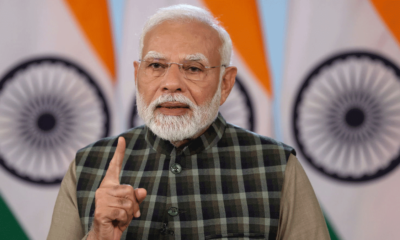E&E
LG Energy and JSW Energy Invest $1.5B to Boost India’s EV Growth: What You Need to Know
LG Energy Solution and JSW Energy announce a $1.5 billion joint venture to produce batteries for electric vehicles and renewable energy in India, supporting the nation’s green initiatives.

LG Energy Solution, a leading global battery manufacturer, and JSW Energy, one of India’s top energy companies, have launched a joint venture with an investment of over $1.5 billion. This partnership aims to produce high-quality electric vehicle batteries for the growing Indian EV market and renewable energy storage systems, supporting India’s push for green energy and clean transportation.
“Strengthening Local Battery Manufacturing”
The new joint venture supports the Indian government’s goals to reduce carbon emissions and increase the use of electric vehicles.
By making batteries in India, LG Energy Solution and JSW Energy plan to cut down on imported batteries. This move will lower EV costs, making electric cars more affordable for more people in India. Additionally, the project supports the “Make in India” campaign, which encourages local battery manufacturing and innovation.
“A strong local battery industry is essential for the growth of India’s EV market,” said a spokesperson from LG Energy Solution. “Partnering with JSW Energy will help us lower production costs and provide advanced electric vehicle batteries tailored to India’s needs.”
Expanding the Electric Vehicle Market
India’s EV market is growing quickly due to rising environmental concerns and supportive government policies. However, high battery costs have slowed the widespread adoption of electric vehicles. The joint venture plans to produce lithium-ion and solid-state batteries on a large scale. This increase in production is expected to lower EV prices, encouraging more people to buy electric cars. Moreover, the venture will help develop renewable energy storage solutions, which are crucial for effectively using solar and wind power.
“Enhancing Renewable Energy Storage”
JSW Energy’s CEO emphasized the importance of energy storage for a sustainable future.
“Reliable energy storage is key to any renewable energy plan. Our partnership with LG Energy Solution will help India store and use renewable energy efficiently. This will improve grid stability and move us closer to our goal of net-zero emissions by 2070.”
“Leveraging Government Incentives”
The partnership will benefit from various government incentives, including subsidies and tax breaks under programs like the Faster Adoption and Manufacturing of Hybrid and Electric Vehicles (FAME) scheme.
These incentives aim to increase both the supply and demand for EVs, supporting the joint venture’s goals.
“Reducing Import Dependence”
The joint venture also aims to reduce India’s reliance on imported batteries, especially from China, which currently leads the global battery manufacturing market.
By producing batteries locally, LG Energy Solution and JSW Energy are positioning India as a significant player in the global battery industry. This move could attract more international investments into India’s green energy sector.
“Creating Jobs and Driving Technology”
As the joint venture progresses, it is expected to create many jobs and drive technological advancements in battery manufacturing.
The collaboration will make electric vehicles more affordable and enhance India’s renewable energy infrastructure, supporting the country’s move towards a low-carbon economy.
“Paving the Way for a Greener Future”
The partnership between LG Energy Solution and JSW Energy marks an important step in India’s journey towards energy independence and sustainable growth.
With substantial investment and strong alignment with national policies, the joint venture is set to drive India’s electric vehicle revolution and strengthen its renewable energy capabilities. This collaboration will help pave the way for a greener and more sustainable future for India.
Watch and Subscribe to the YouTube Channel: EBT Entrepreneur Business Times
E&E
BHEL’s Financial Recovery and Growth in Renewable Energy: What You Need to Know
BHEL has made a strong financial recovery, posting a profit of 966.7 million rupees, driven by growth in the power sector and its focus on green energy investments.

Bharat Heavy Electricals Limited (BHEL), one of India’s leading power equipment manufacturers, has experienced a strong financial recovery in the second quarter of this fiscal year. The company reported a profit of 966.7 million rupees ($11.5 million), turning around from a loss of 583 million rupees during the same period last year. This recovery is driven by significant growth in the power sector and BHEL’s strategic focus on renewable energy and green energy technologies.
“BHEL’s Revenue Growth Fuels the Recovery”
A key factor in BHEL’s financial recovery has been its impressive revenue growth. Operational revenue surged by 28.5%, reaching 65.84 billion rupees. The power sector, which plays a central role in BHEL’s business, has been a major driver of this success. India’s rapidly evolving energy sector, including power generation, transmission, and distribution, has provided a solid foundation for BHEL’s growth.
With an increasing emphasis on clean energy and infrastructure development, BHEL has strategically positioned itself to benefit from the shift toward renewable energy sources. By focusing on these high-demand areas, the company has strengthened its market position and contributed to overall power sector growth.
“Overcoming Challenges with Resilience”
BHEL has faced multiple challenges in recent years, including project delays, tough competition, and the impacts of the COVID-19 pandemic. However, the company has shown resilience in overcoming these obstacles. BHEL focused on improving project execution, streamlining operations, and ensuring the timely delivery of power equipment, all of which contributed to its financial recovery.
Alongside operational improvements,
BHEL has implemented cost-saving strategies. These include reducing overhead costs, enhancing production efficiency, and optimizing its supply chain. These actions have enabled the company to remain profitable, even in the face of rising costs and global supply chain disruptions, all while contributing to green energy initiatives.
“Growing Order Book Reflects Strong Market Position”
BHEL’s expanding order book is a clear indication of its strong market position. The company has secured multiple contracts for critical power equipment, including turbines, generators, and transformers. This growing order backlog positions BHEL well for future growth, as demand for power equipment continues to rise in India.
Additionally
BHEL’s efforts to expand into international markets, particularly in emerging economies, will help diversify its revenue streams and support long-term growth, contributing to global green energy solutions.
“Investing in Green Technologies for Sustainable Growth”
BHEL is focusing on green energy solutions as a key part of its long-term growth strategy. As India continues its push to reduce carbon emissions, BHEL is expanding its product offerings to include wind and solar power technologies. These areas are expected to drive future growth, as India shifts toward a low-carbon economy. Furthermore, BHEL is committed to reducing its carbon footprint, aligning with India’s broader sustainability goals, and boosting the country’s renewable energy capacities.
“Conclusion: “
Positioned for Success in the Future
BHEL’s financial recovery demonstrates the company’s ability to adapt to industry challenges while capitalizing on emerging opportunities in the power sector and green energy sectors. With a solid financial foundation, a growing order book, and a focus on renewable energy, BHEL is well-positioned to remain a leading player in India’s evolving energy market for years to come.
Watch and Subscribe to the YouTube Channel: EBT Entrepreneur Business Times
E&E
Exicom’s Ambitious EV Charging Plans: What You Need to Know
Exicom Tele-Systems is targeting global leadership in the EV charging market, aiming for 50% of its revenue from this sector by 2030.

Exicom Tele-Systems, a leading player in India’s EV charging industry, has set ambitious plans to become a global leader in the EV charging market. The company aims to have its EV charger business contribute 50% of its total revenue by 2030. This goal aligns with the rising demand for electric vehicles (EVs) worldwide and the growing need for sustainable transportation solutions.
“Focusing on EV Charging”
Exicom has been supplying EV chargers to major Indian car manufacturers like Mahindra & Mahindra and MG Motor.
With India pushing for cleaner transportation options and government policies encouraging EV adoption, Exicom is focusing more on the EV charging market. This shift supports India’s goals to reduce carbon emissions, promote renewable energy, and decrease reliance on fossil fuels. As the demand for electric vehicles continues to grow, Exicom is ready to meet the increasing need for accessible and efficient EV charging infrastructure.
Government policies such as the Faster Adoption and Manufacturing of Hybrid and Electric Vehicles (FAME) scheme are key drivers of this shift. These initiatives promote local manufacturing and support the growth of the EV market, allowing Exicom Tele-Systems to be a major contributor to India’s green future.
“Boosting Manufacturing in India”
To meet the rising demand for EV chargers in India, Exicom is heavily investing in its manufacturing capabilities.
The company is building a new plant in Hyderabad to significantly increase production capacity. By manufacturing locally, Exicom can offer more affordable charging solutions, which is crucial for speeding up the adoption of electric vehicles across India. This expansion also supports India’s “Make in India” initiative, which encourages local manufacturing and the creation of new jobs.
Exicom’s new plant will also contribute to India’s goal of becoming a global hub for sustainable manufacturing, particularly in the electric vehicle and renewable energy sectors. This move aligns with the country’s vision for a cleaner and more sustainable future.
“Expanding Globally”
While Exicom is focusing on the Indian market, it is also planning international expansion.
As the global EV market continues to grow, Exicom is targeting international markets in Southeast Asia, Europe, and the United States, where demand for EV charging infrastructure is also increasing. Southeast Asia, with its rapid urbanization and interest in sustainable technology, presents a promising market for Exicom’s charging solutions. Europe, a leader in EV adoption, offers a mature market, while the U.S., one of the largest consumers of electric vehicles, presents a significant opportunity for Exicom to grow its business.
Through expansion into these international markets, Exicom aims to capitalize on the global shift towards electric vehicles and clean energy. The company plans to establish itself as a reliable provider of sustainable EV charging solutions worldwide.
“Looking to the Future”
Exicom Tele-Systems is well on its way to becoming a major player in the global EV charging market. By expanding manufacturing in India and targeting international markets, Exicom is positioning itself for success. With more countries supporting electric vehicles and clean energy, Exicom’s goal of generating 50% of its revenue from EV chargers by 2030 is both achievable and promising.
As the demand for electric vehicles and charging infrastructure continues to rise globally, Exicom Tele-Systems has an excellent opportunity to grow its business. Through innovation, sustainability, and global expansion, Exicom is ready to play a transformative role in the future of electric transportation and renewable energy.
Watch and Subscribe to the YouTube Channel: EBT Entrepreneur Business Times
E&E
India’s $5 Billion Electronics Manufacturing Incentive: What You Need to Know
India is set to offer $4–5 billion in incentives to boost local electronics manufacturing, reduce import dependence, and create thousands of new jobs in the sector.

India Launches $4–5 Billion Incentive Program to Boost Electronics Manufacturing
India is launching a major initiative to support local electronics manufacturing by offering up to $5 billion in incentives. This new program, which will start in the coming months, aims to reduce India’s reliance on Chinese imports and strengthen the country’s position in the global electronics market. The initiative is part of India’s long-term plan to improve its electronics manufacturing sector and become a significant player in the global supply chain.
“Focusing on Key Electronic Components”
The program will focus on producing essential components like printed circuit boards (PCBs), which are crucial for many electronic devices such as smartphones, laptops, and medical equipment.
As demand for electronics in India rises, this move is part of the government’s plan to boost self-reliance and strengthen the country’s manufacturing sector. These components are critical to the broader Indian electronics sector, which is expected to see significant growth in the coming years.
“The goal of this program is to reduce dependence on imports, especially from China, and support the production of high-quality components that meet both domestic and international standards,” said a government official involved in the program.
“Incentives for Local Manufacturers”
Both existing and new companies will be eligible for various incentives, including tax breaks and financial subsidies.
These incentives are designed to make local production more competitive, attract foreign investment, and help India meet the growing demand for electronics both within the country and abroad. This program is also a response to disruptions in global supply chains, particularly during the COVID-19 pandemic. These challenges highlighted the need for India to build a more resilient economy by improving its local electronics manufacturing capabilities.
“Job Creation and Support for Small Businesses”
The $4–5 billion in incentives will be directed toward companies that establish or expand manufacturing units in India.
This is expected to create thousands of new jobs, particularly in regions known for electronics manufacturing. The initiative also aims to support small and medium-sized enterprises (SMEs) in the electronics supply chain, ensuring that the benefits of the program reach a wide range of businesses, from large manufacturers to local suppliers.
“Improving India’s Global Position”
This incentive program also seeks to improve India’s standing in global electronics supply chains.
By enhancing the quality and cost-effectiveness of locally produced components, India hopes to attract global electronics companies looking to diversify their supply chains away from China. As the Indian electronics sector strengthens, India aims to position itself as a key player in the global market for critical components such as PCBs and other high-demand technologies.
The government has already introduced measures to attract foreign investment into India’s electronics sector, including offering financial incentives to companies investing in research, development, and the establishment of production facilities. The goal is to create a thriving ecosystem for electronics manufacturing within India, supporting both domestic demand and international export opportunities.
“A Stronger, Self-Reliant Electronics Sector”
“India has the potential to become a leader in global electronics manufacturing.
This program will help build a more competitive sector, ensuring India’s place in the future of technology,” said an industry expert. With this initiative, India is taking concrete steps to reduce its dependence on imports and transform its electronics manufacturing industry into a global leader.
India’s electronics industry has long relied on imports, especially from China, the world’s largest supplier of electronic components. With this new incentive program, the Indian government is committed to transforming the country into a global hub for electronics manufacturing. This program not only aims to reduce India’s reliance on imports but also seeks to build a resilient electronics supply chain.
“A Boost for India’s Economy and Digital Future”
In the long run, the program is expected to give a significant boost to India’s economy and support the country’s digital transformation. It will also enhance India’s position as a global leader in technology manufacturing. With this initiative, India aims not only to reduce its dependence on imports but also to create a thriving ecosystem for electronics production, driving innovation and job growth across the country. The success of this program is expected to lead to a more self-sufficient Indian manufacturing sector, well-positioned to compete on the global stage.
Watch and Subscribe to the YouTube Channel: EBT Entrepreneur Business Times
-

 Cover Story2 weeks ago
Cover Story2 weeks agoDonald Trump’s Key Policies: Essential Insights You Need to Know
-

 Cover Story2 weeks ago
Cover Story2 weeks agoMaha Kumbh Mela 2025: Essential Insights You Need to Know
-

 Cover Story2 weeks ago
Cover Story2 weeks agoNarendra Modi’s Leadership and Vision for India’s Future: What You Need to Know
-

 Business2 weeks ago
Business2 weeks agoWomen Entrepreneurs’ Impact on Business Growth: What You Need to Know
-

 Pharma1 month ago
Pharma1 month agoIndia’s Pharma Industry Transformation: What You Need to Know
-

 EV1 month ago
EV1 month agoIndia’s New EV Charging Guidelines: Essential Insights You Need to Know
-

 Auto1 month ago
Auto1 month agoOsamu Suzuki’s Impact on India’s Automotive Industry: What You Need to Know
-

 Pharma1 month ago
Pharma1 month agoIndia’s Pharmaceutical Growth: What You Need to Know














